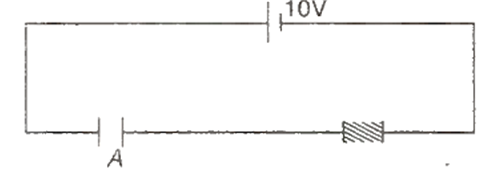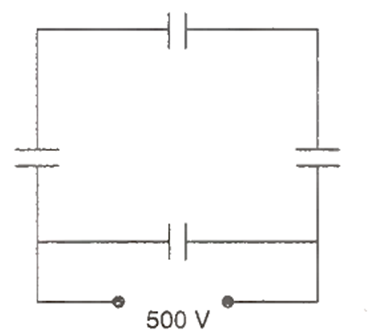 Multiple Choice Questions
Multiple Choice QuestionsA parallel plate capacitor of capacitance 10 F is charged to 1 µC. The charging battery is removed and then the separation between the plates is doubled. Work done during the process is
5 mJ
0.05 mJ
1 mJ
10 mJ
The potential at a point P which is forming a corner of a square of side 93 mm with charges, Q1 = 33 nC, Q2 = − 51 nC, Q3 = 47 nC located at the other three corners is already
16 kV
4 kV
400 V
160 V
The capacitors A and B have identical geometry. A material with a dielectric constant 3 is present between the plates of B. The potential difference across A and B are respectively

2.5 V, 7.5 V
2 V, 8 V
8 V, 2 V
7.5 V, 2.5 V
Four 10 F capacitors are connected to a 500 V supply as shown in the figure. The equivalent capacitance of the network is

40 μF
20 μF
13.3 μF
10 μF
Small rain drops of the same size are charged to potential V volts each. If n such drops coalesce to form a single drop, then the potential of the bigger drop is
n1/3 V
n2/3 V
nV
n3/2 V
A parallel plate capacitor has plate of area A and separation d. It is charged to a potential difference V0. The charging battery is disconnected and the plates are pulled apart to three times the initial separation. The work required to separate the plates is
A small sphere is charged to a potential of 50 V and a big hollow sphere is charged to potential of 100 V. Charge will flow from the smaller sphere to the bigger one when
the smaller one is placed inside the bigger one and connected by a wire
the bigger one is placed inside the smaller one and connected by means of a wire
bigger one placed by the side of the smaller one and connected by a wire
smaller one placed by the side of the bigger one
Capacitance of a parallel plate capacitor becomes times its original value, if a dielectric slab of thickness is inserted between the plates [d is the separation between the plates]. The dielectric constant of the slab is
4
8
2
6
C.
2
The capacitance of air capacitor
When a dielectric slab of thickness t = d /2 is inserted between plates, the capacity becomes
